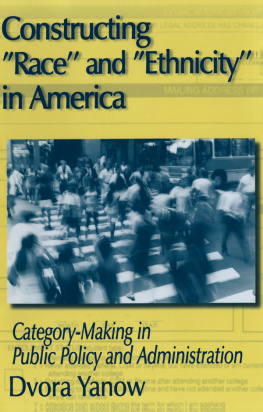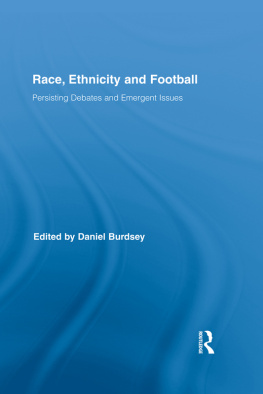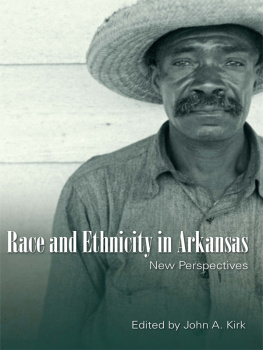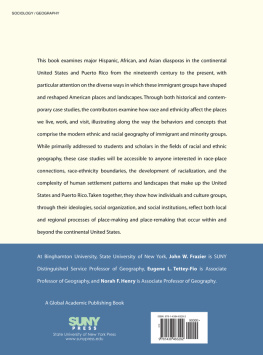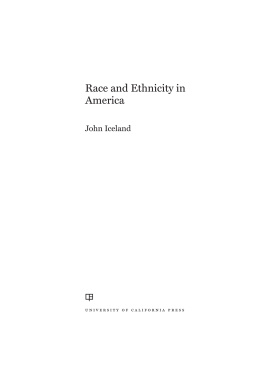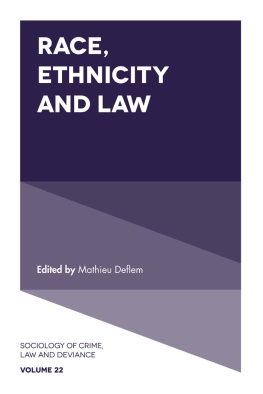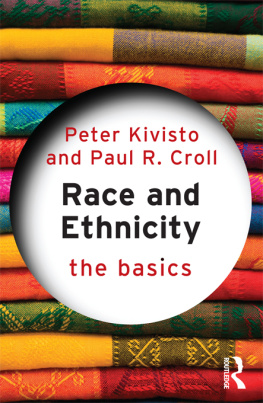Constructing Race and Ethnicity in America
First published 2003 by M.E. Sharpe
Published 2015 by Routledge
2 Park Square, Milton Park, Abingdon, Oxon OX14 4RN
711 Third Avenue, New York, NY 10017, USA
Routledge is an imprint of the Taylor & Francis Group, an informa busin
Copyright 2003 Taylor & Francis. All rights reserved.
No part of this book may be reprinted or reproduced or utilised in any form or by any electronic, mechanical, or other means, now known or hereafter invented, including photocopying and recording, or in any information storage or retrieval system, without permission in writing from the publishers.
Notices
No responsibility is assumed by the publisher for any injury and/or damage to persons or property as a matter of products liability, negligence or otherwise, or from any use of operation of any methods, products, instructions or ideas contained in the material herein.
Practitioners and researchers must always rely on their own experience and knowledge in evaluating and using any information, methods, compounds,or experiments described herein. In using such information or methods they should be mindful of their own safety and the safety of others, including parties for whom they have a professional responsibility.
Product or corporate names may be trademarks or registered trademarks, and are used only for identification and explanation without intent to infringe.
Library of Congress Cataloging-in-Publication Data
Yanow, Dvora
Constructing race and ethnicity in America : category-making in public policy and administration / by Dvora Yanow.
p. cm.
Includes bibliographical references and index.
ISBN 0-7656-0800-6 (he: alk. paper) ISBN 0-7656-0801-4 (pbk.: alk. paper)
1. Group identityUnited States. 2. Race. 3. Ethnicity. I. Title.
| HM753Y36 2002 |
| 305.800973dc21 | 2002024500 |
ISBN 13: 9780765608017 (pbk)
ISBN 13: 9780765608000 (hbk)
Table of Contents
Two men were walking along the river. One said to the other,
Look how happy the fish are as they swim in the river!
The other said,You are not a fish.
How do you know whether the fish are happy?
The first replied,You are not me. How do you know
whether I know what the fish think?
Chinese fable (from Minow 1990, p. 227)
Similarly the Russian radical Alexander Herzen observed
that we classify creatures by zoological types,
according to the characteristics and habits
that are most frequently to be found conjoined.
Thus, one of the defining attributes of fish
is their liability to live in water,
hence, despite the existence of flying fish,
we do not say offish in general
that their nature or essence
the true end for which they were created
is to fly, since most fish fail to achieve this
and do not display the slightest tendency in this direction.
Isaiah Berlin, Four Essays on Liberty (quoted in Gray 1996
to explore and to celebrate the similarities
which join us in the human community,
and the differences between us which make us
fascinating to each other;
to reveal the other in ourselves ;
to provoke laughter and tears,
to excite, to startle, to shock
Jeanne Cannizzo and David Parry (1994, p. 45)
From this promiscuous breed
has risen
that race now called
Americans.
Crvecoeur (quoted in Jefferson 1999, p. E2)
What do we mean in the United States today when we use the terms race and ethnicity? What do we mean, and what do we understand, when we use the standard set of five race-ethnic categories: White, Black, Asian-American, Native American, Hispanic/Latino/a (or their variant forms)?
It has become commonplace in the academyamong the social sciences in particular, from anthropology, sociology, and ethnic studies to some fields of political science, especially political theoryto speak of race and ethnicity and their specific categories (e.g., African-American, Asian-American, Native American) as socially constructed concepts. That is, they are perceived and understood to be human inventions, created to impose some sense of order on the surrounding social world, often for political purposes. This means that they are variable, rather than fixed and stable. Indeed, a historical view of groups and individuals considered White on some occasions and Black on others shows this to be the case.
And yet, in many areas of the contemporary administration of public policies, both concepts and categories are used in precisely the opposite wayas if they were fixed, stable, and scientifically grounded in the human social world, as if they did correspond to some naturally occurring reality. This book explores this seeming conundrum: why it is that social and biological scientists current understanding of race and ethnicity has not made inroads into policy and administrative practices. In analyzing several of these practices, it becomes clear that the answer lies in the practices themselves: the ways in which race, ethnicity, and their categories are used in policy and administrative arenas undergird and sustain a public perception of them as scientifically factual.
In many areas of the contemporary administration of public policies, we ask others or are asked ourselves for identification by race-ethnic makeup. Policy and administrative uses of the five standard race-ethnic terms now most commonly occurring create categories of Americans for political purposes, and such ongoing, commonplace, everyday usage sustains themor introduces opportunities for change. The widespread use of race and ethnicity and their terms evokes their societal importance and centrality in the United States today for the crafting of individual identity. This contemporary discourse creates, maintains, and reifies concepts and categories of race and ethnicity that have no empirical grounding either in the natural world or in any accepted scientific field studying that human world.
American ethnogenesisthe creation of the peoples of the United Statesis thereby achieved through the use of these two kinds of demographic categoriesracial and ethnic. Contemporary race-ethnic discourse is marked by the interweaving of two sets of meanings concerning personal and political identity: the concepts of race and ethnicity themselves, and their specific attendant categories. Such ethnogenesis is accomplished in large measure without explicit attention: category making is a mode of implicit reasoning. But this implicit reasoning leads to explicit actionsboth in the realm of individual identity practices and in the crafting of social policies and their implementation. Policy and administrative practices sustain the reification of a set of categorical relationships that, were we but explicitly cognizant of them, many would likely disown. It is my hope in this book to begin to make some of these silences in public discourse speak.
Race-ethnic identity is complex and multifaceted. Part of that complexity is that although race and ethnicity are often used to refer to different things, they are also used interchangeably. For this reason I use race-ethnic in this book as a single referent for both. This lack of terminological clarity is part of the subject of my argument. To draw attention to their arti-factual character, as distinct from the scientific character in which spirit they are commonly used, I should put quotation marks around race and ethnicity consistently throughout the book. I have not done so for editorial reasons, but I invite the reader to envision them marked in this way.

